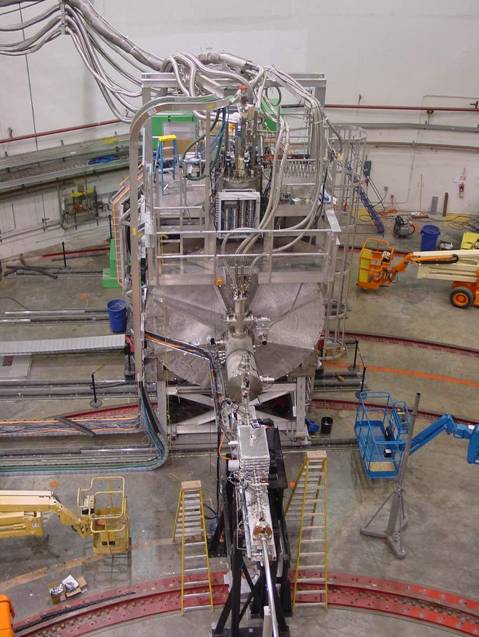Links

The G0 Experiment apparatus installed in Jefferson Lab Hall C
Technical summary and status of experiment (June 02; pdf 1.26 Mb)
The G0 Experiment
Caltech, Carnegie Mellon, Hampton, Illinois, IPN Orsay, ISN Grenoble, Jefferson Lab,
Kentucky, Louisiana Tech, Manitoba, Maryland, Massachusetts, New Mexico State,
Northern British Columbia, TRIUMF, Virginia Tech, William & Mary, Yerevan

Schematic of G0 Experiment
The G0 experiment measures the scattering of electrons by protons. The apparatus consists of the beam of polarized electrons from the Jefferson Lab accelerator, a liquid hydrogen target which provides the protons for the scattering and a spectrometer to measure the scattering products. The actual measurement will be performed in two phases. In the first, a proton recoiling from its interaction with an electron will be bent in the magnetic field produced by the superconducting coils according to its speed (momentum). Protons of different momenta, bending by different amounts in the magnetic field, will strike the array of paricle detectors in different places. These detectors consist of pairs of crescent-shaped pieces of a special plastic (called scintillator) which emits light when a particle such as a proton passes through it. In the second phase the whole apparatus will be reversed relative to the beam direction and scattered electrons rather than protons will be detected.
The particular feature of the experiment that makes it both new and challenging is that it will determine a very small, special piece of the overall interaction of electrons and protons. Because of the close relationship between the electromagnetic and weak interactions, it is interesting to compare these two interactions for nucleons. This comparison will allow us to isolate the strange quark contribution. The electromagnetic interaction is well measured; this experiment is designed to measure the weak interaction. Observation of the weak interaction requires that we compare the experiment and its mirror image. The mirror image is "produced" by reversing the beam polarization, i.e. changing the direction of the electron spins in the beam from parallel to anti-parallel to its direction of motion. The weak interaction effect is therefore determined by measuring the difference in the number of scattered protons when the electron beam is polarized with electron spins parallel to their direction of travel as compared to anti-parallel. The relative difference of these numbers is very small - only a few parts in a million. The G0 experiment is carefully designed to reduce to an acceptable level false signals that could mimic the physics effect we are interested in.
|
Links |

The G0 Experiment apparatus installed in Jefferson Lab Hall C |
|
Technical summary and status of experiment (June 02; pdf 1.26 Mb) |
|